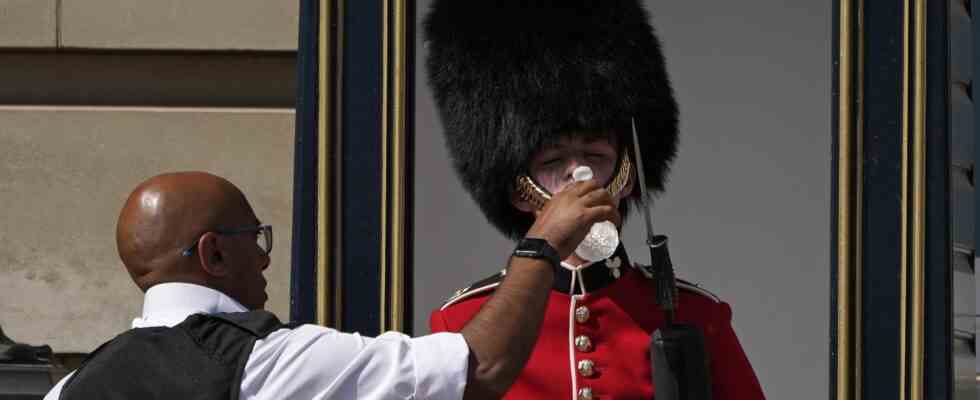Status: 07/19/2022 11:06 a.m
In view of the persistent heat, several European countries are activating their emergency plans: France is setting up “cold rooms”, and fans at a British agricultural fair are supposed to keep people and animals cool.
Spain: Observation plan for the elderly, the sick and the poor
There is no overarching national heat emergency plan in Spain. But of course recommendations from the Ministry of Health, as well as warning and prevention plans in the autonomous regions and administrations. The aim is to keep health risks as low as possible. The multi-stage warning system of the meteorological service serves as a guideline. In Madrid, for example, because heat waves are now an integral part of the Spanish summer, an observation schedule is automatically triggered on June 1 and remains active until mid-September. Other regions do the same.
The focus is on groups that are particularly at risk, i.e. the sick and the elderly, especially if they live alone without additional support, but also people with little money, some of whom live together in a small space without air conditioning. Because small apartments in particular can heat up to more than 40 degrees. For example, if the heat warning level is red – that is, if temperatures of more than 38.6 degrees are forecast for four consecutive days – health and social services, for example, will be informed. You can then get in touch directly with those who are particularly vulnerable, for example through home visits, to find out what extra support people need. But the system is expandable.
UK: Routine appointments in clinics cancelled
Higher temperatures than yesterday are expected in Great Britain today, meteorologists believe that the 41-degree mark could be reached. For the first time in England’s history, the heat alert level is red, which means: “Danger to life and limb”. The British health authority also issued the highest warning level, which corresponds to a national emergency. She advises drinking plenty, staying in the shade or indoors, and looking after those who are particularly vulnerable.
Routine appointments in clinics have been canceled to create capacity for heat victims. Some schools remain closed, sports festivals have been postponed, and rail traffic has been reduced or stopped on individual routes. Tracks had been painted white in advance to reflect the heat.
The Royal Welsh Agricultural Show in Wales, which is expected to attract 50,000 visitors in the coming days, is also suffering from the heat. Organizers have invested tens of thousands of extra pounds in fans to keep the 8,000 or so animals as cool as possible. Organizer Harry Fetherstonhaugh explained that extra shadow zones had been created and that in case of doubt more time would be given for the awards, otherwise the show would go through: “Particularly sensitive pig breeds were wrapped in wet towels and smeared with sunscreen.”
The British government has come under criticism for its handling of the heat wave: Prime Minister Boris Johnson skipped two crisis meetings on the subject. His deputy Dominic Raab called for “enjoying” the sunshine at the weekend.
Belgium: Bakeries are to close earlier
It’s supposed to be hot in Belgium today: up to 40 degrees are expected after 36 degrees were measured yesterday. That is why the Royal Meteorological Institute announced the penultimate warning level in the heat plan, orange, a few days ago. It focuses on particularly vulnerable groups such as the elderly, small children and the homeless. Avoiding the sun, drinking plenty of fluids and closing windows and doors are recommended to avoid heat stroke and dehydration.
Due to the hot weather, high ozone levels are also expected. That means the air quality is worse than usual. This can cause breathing difficulties or irritated eyes. The Belgians should therefore not try too hard. According to media reports, bakeries and butchers want to take precautions by closing earlier. Garbage collection should also start earlier.
France: information on heat stroke
The Plan Canicule, the national heat plan, is activated in France every summer – a system with four different warning levels from green to red. As early as the penultimate stage – orange – the first emergency measures come into force: In the affected regions, cities and communities set up “cold rooms”, such as air-conditioned town hall halls, for all the people whose homes it is no longer bearable. The media and the websites of the regions and the government provide information about the symptoms of heat stroke, among other things, and the government has an emergency telephone number. Town halls must contact single elderly people and offer them help during the extreme heat if necessary.
The highest warning level of the Plan Canicule comes into effect when temperatures exceed 40 degrees. Then the prefects of the affected regions can, for example, cancel outdoor events, close public facilities such as kindergartens and crèches, the fire brigade is put on alert in forest fire regions and the hospitals prepare for more patients. The Canicule plan has existed in France since 2004. The country learned from the heat wave of 2003: At that time, more than 15,000 people died, mostly elderly and single people, as a result of the extreme heat. The cooling chambers were no longer sufficient to accommodate the dead, and the Rungis wholesale market near Paris was converted into a morgue.

